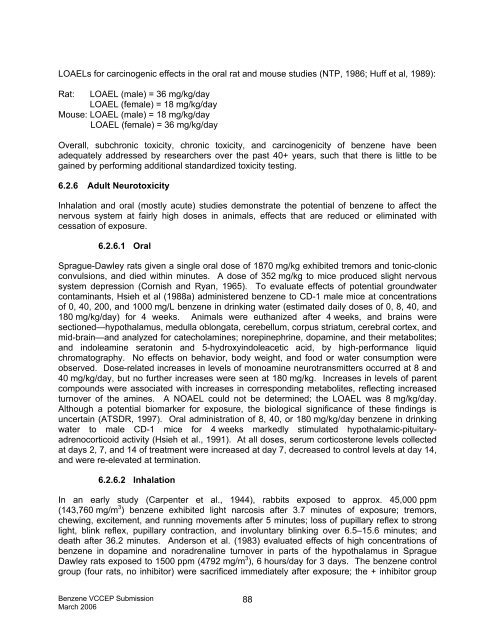(VCCEP) Tier 1 Pilot Submission for BENZENE - Tera
(VCCEP) Tier 1 Pilot Submission for BENZENE - Tera
(VCCEP) Tier 1 Pilot Submission for BENZENE - Tera
You also want an ePaper? Increase the reach of your titles
YUMPU automatically turns print PDFs into web optimized ePapers that Google loves.
LOAELs <strong>for</strong> carcinogenic effects in the oral rat and mouse studies (NTP, 1986; Huff et al, 1989):<br />
Rat: LOAEL (male) = 36 mg/kg/day<br />
LOAEL (female) = 18 mg/kg/day<br />
Mouse: LOAEL (male) = 18 mg/kg/day<br />
LOAEL (female) = 36 mg/kg/day<br />
Overall, subchronic toxicity, chronic toxicity, and carcinogenicity of benzene have been<br />
adequately addressed by researchers over the past 40+ years, such that there is little to be<br />
gained by per<strong>for</strong>ming additional standardized toxicity testing.<br />
6.2.6 Adult Neurotoxicity<br />
Inhalation and oral (mostly acute) studies demonstrate the potential of benzene to affect the<br />
nervous system at fairly high doses in animals, effects that are reduced or eliminated with<br />
cessation of exposure.<br />
6.2.6.1 Oral<br />
Sprague-Dawley rats given a single oral dose of 1870 mg/kg exhibited tremors and tonic-clonic<br />
convulsions, and died within minutes. A dose of 352 mg/kg to mice produced slight nervous<br />
system depression (Cornish and Ryan, 1965). To evaluate effects of potential groundwater<br />
contaminants, Hsieh et al (1988a) administered benzene to CD-1 male mice at concentrations<br />
of 0, 40, 200, and 1000 mg/L benzene in drinking water (estimated daily doses of 0, 8, 40, and<br />
180 mg/kg/day) <strong>for</strong> 4 weeks. Animals were euthanized after 4 weeks, and brains were<br />
sectioned—hypothalamus, medulla oblongata, cerebellum, corpus striatum, cerebral cortex, and<br />
mid-brain—and analyzed <strong>for</strong> catecholamines; norepinephrine, dopamine, and their metabolites;<br />
and indoleamine seratonin and 5-hydroxyindoleacetic acid, by high-per<strong>for</strong>mance liquid<br />
chromatography. No effects on behavior, body weight, and food or water consumption were<br />
observed. Dose-related increases in levels of monoamine neurotransmitters occurred at 8 and<br />
40 mg/kg/day, but no further increases were seen at 180 mg/kg. Increases in levels of parent<br />
compounds were associated with increases in corresponding metabolites, reflecting increased<br />
turnover of the amines. A NOAEL could not be determined; the LOAEL was 8 mg/kg/day.<br />
Although a potential biomarker <strong>for</strong> exposure, the biological significance of these findings is<br />
uncertain (ATSDR, 1997). Oral administration of 8, 40, or 180 mg/kg/day benzene in drinking<br />
water to male CD-1 mice <strong>for</strong> 4 weeks markedly stimulated hypothalamic-pituitaryadrenocorticoid<br />
activity (Hsieh et al., 1991). At all doses, serum corticosterone levels collected<br />
at days 2, 7, and 14 of treatment were increased at day 7, decreased to control levels at day 14,<br />
and were re-elevated at termination.<br />
6.2.6.2 Inhalation<br />
In an early study (Carpenter et al., 1944), rabbits exposed to approx. 45,000 ppm<br />
(143,760 mg/m 3 ) benzene exhibited light narcosis after 3.7 minutes of exposure; tremors,<br />
chewing, excitement, and running movements after 5 minutes; loss of pupillary reflex to strong<br />
light, blink reflex, pupillary contraction, and involuntary blinking over 6.5–15.6 minutes; and<br />
death after 36.2 minutes. Anderson et al. (1983) evaluated effects of high concentrations of<br />
benzene in dopamine and noradrenaline turnover in parts of the hypothalamus in Sprague<br />
Dawley rats exposed to 1500 ppm (4792 mg/m 3 ), 6 hours/day <strong>for</strong> 3 days. The benzene control<br />
group (four rats, no inhibitor) were sacrificed immediately after exposure; the + inhibitor group<br />
Benzene <strong>VCCEP</strong> <strong>Submission</strong><br />
March 2006<br />
88





